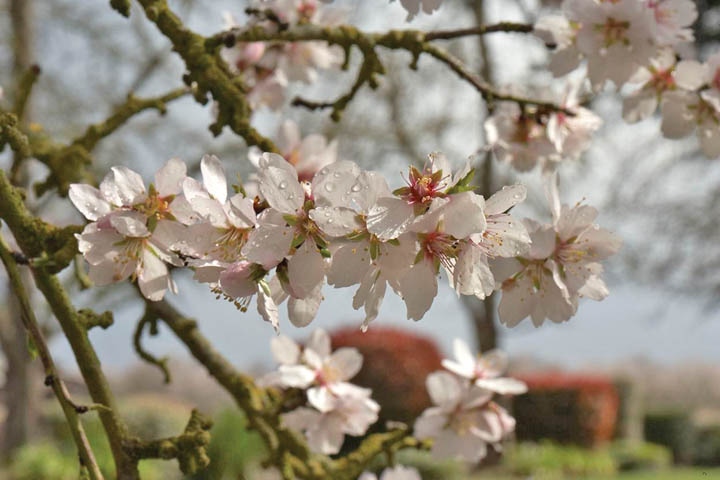
Almond options available for bloom and foliar diseases
A wet winter that has soaked California north to south has provided for the summer irrigation season by filling reservoirs and creating a record-breaking snowpack. But what effect the wet winter will have on this year’s almond bloom depends on what happens next.More rain at this time of year means California almond growers will have to be on guard for almond blossom and foliar diseases as the bloom period begins. Fortunately, there are a number of good fungicide options for these diseases and more are on the way.
February 3, 2011

A wet winter that has soaked California north to south has provided for the summer irrigation season by filling reservoirs and creating a record-breaking snowpack. But what effect the wet winter will have on this year’s almond bloom depends on what happens next.
More rain at this time of year means California almond growers will have to be on guard for almond blossom and foliar diseases as the bloom period begins. Fortunately, there are a number of good fungicide options for these diseases and more are on the way.
Professor and plant pathologist Dr. Jim Adaskaveg, UC Riverside, conducted field and laboratory studies last season to identify fungicide programs for the management of brown rot blossom blight, shot hole and jacket rot (green fruit rot). He reported his findings at the Almond Industry Conference last December.
His work shows that there are several highly effective single fungicides and fungicide premixtures for the management of these diseases. He also evaluated biofungicides for almond disease management. This array of available effective materials, when applied in rotation or in tank-mix programs, will help to prevent the selection and buildup of resistant pathogen populations. Resistance to the more recently introduced fungicides has not been found in almond populations of Monilinia laxa (brown rot) or Wilsonmyces carpophilus (shot hole), but is common in other diseases such as Cladosporium carpophilum (scab) and Alternaria species (leaf spot). With misuse, the same could happen with brown rot and shot hole.
Many newer fungicides carry a high risk for losing efficacy as a result of disease resistance because they have a single-site mode of action, which disease organisms can more easily overcome. When these fungicides are misused by making back-to-back sprays of fungicides in the same class, or applied at low rates or in an alternate-row pattern, fungicide resistance is likely to develop.
The most recent registrations for almond disease management are for use of Ph-D, a polyoxin and a reduced-risk fungicide; Inspire and Quash, both sterol biosynthesis inhibitors (SBIs) with a single-site mode of action; the premixture Quilt Xcel (a QoI and an SBI); and the biofungicides Regalia and Actinovate. Additional products, such as Inspire Super and Quadris Top are pending registration this spring season. Others, such as Luna Sensation, may not be registered in time for the 2011 season. Check with a crop protection professional for the latest information on availability.
Brown rot and shot hole
A number of highly effective fungicides against brown rot are available or will be available soon. The most effective of these, according to Adaskaveg’s research, include Adament, Luna Sensation and Quash. Also very effective are Inspire Super, Inspire XT and Quilt Xcel, which are all premixtures of fungicides that complement each other and improve the efficacy, consistency and spectrum of activity of treatments when compared to the use of the individual fungicides alone.
In a trial to evaluate biologicals and natural products against brown rot, Actinovate, the experimental organic product Ph-D and Cerebrocide significantly reduced brown rot and gray mold as compared to the control. Regalia was less effective against brown rot and ineffective against gray mold, the major pathogen of jacket rot/green fruit rot. All applications were made as single treatments and compared to Vangard, which had the lowest levels of both brown rot and gray mold among treatments evaluated.
The most effective new fungicides for managing shot hole — either registered or soon to be registered — include Syllit, Quadris Top and Quilt Xcel.
Help on the web
There are numerous valuable web resources for disease management to aid in developing fungicide programs. For more information on Dr. Adaskaveg’s research, you can access his report to the Almond Board of California and his poster on the same subject, which was displayed at the Almond Industry Conference. Go to AlmondBoard.com/ResearchReports and search the database by researcher (Adaskaveg). Choose Project No. 09.PATH4.Adaskaveg for the report and 10.PATH4.Adaskaveg for the poster.
Another valuable web resource is the UC Statewide IPM website, where you will find the booklet “Efficacy and Timing of Fungicides, Bactericides and Biologicals for Decidious Tree Fruit, Nut, Strawberry and Vine crops” in the almond section under “More information.” This booklet contains valuable information on almond fungicide efficacy (both synthetics and natural products), treatment timing, and suggested fungicide resistance management programs against various diseases. This online publication is currently being updated for the 2011 season to include the newly registered materials and additional resistance management information.
To access the UC Statewide IPM website and other almond disease management resources, including a CEU course on almond disease management, go to AlmondBoard.com/farmpress14.
You May Also Like



